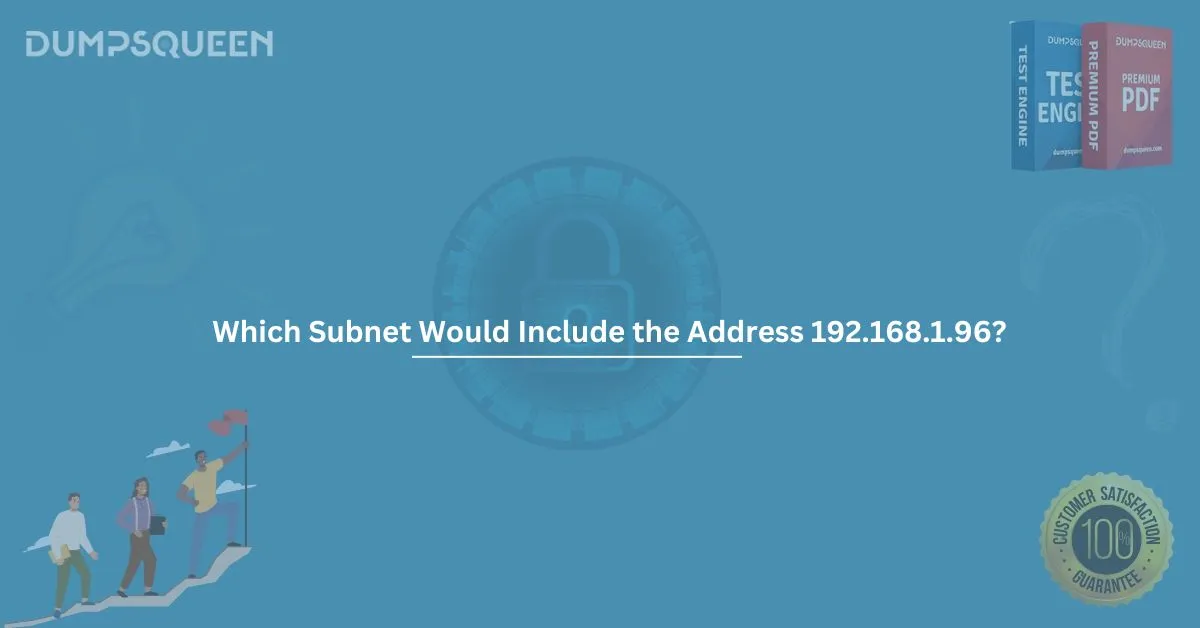Understanding subnetting is one of the most essential topics when preparing for networking certifications. Whether you are studying with Exam Prep Dumps and Study Guide material or following official courses, mastering subnetting can give you a strong advantage. A common question that arises in networking exams and real-world troubleshooting is: which subnet would include the address 192.168.1.96?
In this blog, we will walk through this concept in depth, providing a clear explanation, real-world examples, and practice MCQs to ensure you are fully prepared.
Let's begin.
What is a Subnet?
A subnet, short for "subnetwork," is a segmented piece of a larger network. Subnets allow network administrators to break down large networks into smaller, more manageable sections. This organization enhances performance, improves security, and simplifies network management.
Each subnet is defined by an IP address and a subnet mask. The subnet mask determines which portion of the IP address refers to the network and which part refers to the host.
For example, in the IP address 192.168.1.96 with a subnet mask of 255.255.255.0, the first three octets (192.168.1) represent the network, and the last octet (.96) represents the specific host within that network.
Breaking Down the Question
When we ask which subnet would include the address 192.168.1.96, we need to determine:
- What subnet masks are possible?
- Which network range the IP falls into based on the given mask?
- How to calculate and verify the subnet?
Subnetting can involve different subnet masks like /24, /25, /26, etc. Each mask affects the range of IP addresses available in a subnet.
Let’s break this down step-by-step.
Step 1: Understanding IP Address Classes
First, recall that 192.168.1.96 is a Class C IP address.
Class C addresses typically use a default subnet mask of 255.255.255.0 (or /24), which allows 256 IP addresses (254 usable for hosts).
However, in subnetting scenarios, it is common to divide Class C networks into smaller subnets, like /25, /26, /27, and so forth.
Each increment in the subnet mask (for example, from /24 to /25) halves the number of available addresses.
Step 2: Determine Possible Subnets
Here’s a simple breakdown:
- /24 (255.255.255.0): 192.168.1.0 – 192.168.1.255
- /25 (255.255.255.128):
- Subnet 1: 192.168.1.0 – 192.168.1.127
- Subnet 2: 192.168.1.128 – 192.168.1.255
- /26 (255.255.255.192):
- Subnet 1: 192.168.1.0 – 192.168.1.63
- Subnet 2: 192.168.1.64 – 192.168.1.127
- Subnet 3: 192.168.1.128 – 192.168.1.191
- Subnet 4: 192.168.1.192 – 192.168.1.255
Each subnet size decreases as the subnet mask gets longer.
Now, we must find out where 192.168.1.96 fits.
Step 3: Find the Correct Subnet for 192.168.1.96
If we analyze:
- In a /24 network, 192.168.1.96 fits easily because all addresses from 192.168.1.0 to 192.168.1.255 are included.
- In a /25 network, 192.168.1.96 falls between 192.168.1.0 and 192.168.1.127.
- In a /26 network, there are ranges:
- 192.168.1.0 – 192.168.1.63 (no, 96 is higher)
- 192.168.1.64 – 192.168.1.127 (yes, 96 falls here)
Thus, 192.168.1.96 belongs to the 192.168.1.64/26 subnet.
Answer: 192.168.1.64/26 is the subnet that includes 192.168.1.96.
Step 4: Verifying
Subnet range for 192.168.1.64/26:
- Network Address: 192.168.1.64
- First Host: 192.168.1.65
- Last Host: 192.168.1.126
- Broadcast Address: 192.168.1.127
Since 192.168.1.96 is between 192.168.1.65 and 192.168.1.126, it is indeed inside this subnet.
How Subnetting Applies in Real Life
Understanding subnetting helps in designing efficient networks. For example:
- Dividing a corporate network into smaller subnets for different departments
- Creating subnets for security segmentation
- Optimizing traffic flow
- Troubleshooting network issues more effectively
When studying with Exam Prep Dumps and Study Guide material, you will find numerous scenarios where subnetting plays a crucial role.
Tips for Mastering Subnetting
- Practice Regularly: Subnetting requires continuous practice. Solve as many problems as you can.
- Understand Binary Math: Know how to convert IP addresses and subnet masks into binary and vice versa.
- Use Cheat Sheets: Keep subnetting charts handy when practicing.
- Break It Down: Always break the question into steps — identify class, possible masks, calculate ranges.
- Study Real Scenarios: Practical case studies help you grasp subnetting faster than theory alone.
Common Mistakes When Subnetting
- Incorrectly identifying network and broadcast addresses.
- Confusing the subnet mask notation (/24, /26, etc.)
- Forgetting that the first address is the network address and the last is the broadcast address.
- Misinterpreting binary calculations.
Avoiding these mistakes is critical to succeed in networking exams and practical job roles.
Final Thoughts
When someone asks, "which subnet would include the address 192.168.1.96," the answer is 192.168.1.64/26. However, the real value lies in understanding how to derive that answer confidently.
Whether you're preparing with Exam Prep Dumps and Study Guide material or self-studying, investing time in subnetting will boost your confidence across multiple areas, including exams, interviews, and on-the-job troubleshooting.
Mastering subnetting isn't just about passing an exam—it's about building a strong foundation for a career in networking.
Keep practicing, keep exploring real-world examples, and you’ll soon find subnetting questions easy and intuitive!
Sample MCQ Practice
Here are a few multiple-choice questions to test your understanding:
Question 1:
Which subnet includes the IP address 192.168.1.96?
A) 192.168.1.0/25
B) 192.168.1.64/26
C) 192.168.1.128/26
D) 192.168.1.0/24
Answer: B) 192.168.1.64/26
Question 2:
What is the broadcast address of the subnet 192.168.1.64/26?
A) 192.168.1.127
B) 192.168.1.63
C) 192.168.1.95
D) 192.168.1.126
Answer: A) 192.168.1.127
Question 3:
How many usable host addresses are there in a /26 subnet?
A) 30
B) 62
C) 126
D) 254
Answer: B) 62
Question 4:
In a subnet of 192.168.1.64/26, which of the following is a valid host IP address?
A) 192.168.1.63
B) 192.168.1.64
C) 192.168.1.95
D) 192.168.1.127
Answer: C) 192.168.1.95



